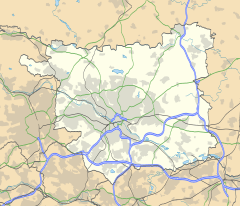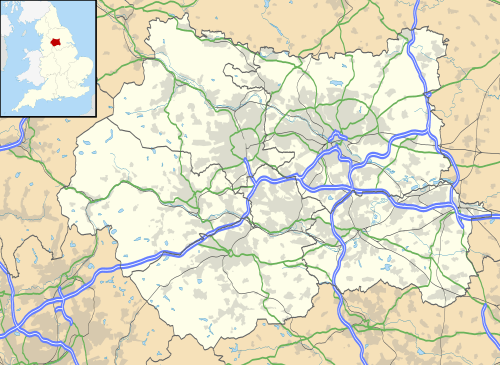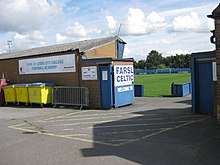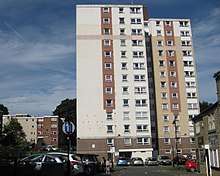Farsley
Farsley is a village in the City of Leeds metropolitan borough, West Yorkshire, England 6 miles (9.7 km) to the west of Leeds city centre, 4 miles (6.4 km) east of Bradford. Farsley is situated between the two cities and is a part of the town Pudsey that is part of the City of Leeds ward of Calverley and Farsley which also includes the estate of Swinnow and some northern parts of Pudsey.[1]
| Farsley | |
|---|---|
 Town Street | |
 Farsley  Farsley Location within West Yorkshire | |
| Metropolitan borough | |
| Metropolitan county | |
| Region | |
| Country | England |
| Sovereign state | United Kingdom |
| Post town | PUDSEY |
| Postcode district | LS28 |
| Dialling code | 0113 |
| Police | West Yorkshire |
| Fire | West Yorkshire |
| Ambulance | Yorkshire |
| UK Parliament | |
It is mentioned in the 1086 Domesday Book as Ferselleia.[2] During the industrial revolution Farsley was a centre for wool processing as there were a number of mills in the area.
Farsley is just off the main road between Leeds and Bradford and just off the A6110 Leeds outer ring road. New Pudsey railway station is between Farsley and Pudsey providing train services towards Leeds, Bradford, Manchester Victoria and Blackpool.
Education
In Farsley there are three primary schools: Farsley Farfield Primary School for 3 to 11 year old children,[3] Westroyd Primary School and Nursery[4] for 3 to 11 year olds, and Farsley Springbank Primary School[5] for 4 to 11 year old pupils. The local secondary school is Priesthorpe School[6] with about 1100 pupils.
Sport

Farsley is home to the non-League football team Farsley Celtic F.C. who play at Throstle Nest. They were formed to replace Farsley Celtic A.F.C. who played in the Football Conference for several years prior to their winding up in March 2010.
Farsley Cricket Club, whose ground is situated in Red Lane, play in the Bradford League Division 1. Raymond Illingworth, former England cricket captain, is their most notable former player.
Housing

Farsley has a variety of housing. Around Town Street are some older terrace houses and smaller cottages. To the west of Town Street is a small council estate, consisting mainly of flats, the tallest block being twelve stories high. Towards the outskirts of Farsley there are many large detached houses.
People
- The Rev. Samuel Marsden (born in Farsley)[7][8] was associated with the reformist William Wilberforce in England, was ordained in 1794, married Elisabeth Fristan, and then sailed to New South Wales, Australia. He arrived in Sydney on 10 March 1794, shortly after the birth of their first child, Anne. By 1795 he was settled in Parramatta, where he became Chaplain, wealthy landowner, farmer and magistrate. He was known as the "Flogging Parson", because even by the standards of his day, he inflicted severe punishments while acting as a magistrate.[7] This has been attributed to a dislike of Roman Catholics and Irish. Joseph Holt, an Irish priest and activist, left on account of a flogging ordered by Marsden. Sheephead Park is a memorial garden dedicated to Marsden and is situated on Farsley Town Street.
- Sculptor John Wormald Appleyard (1831–1894) grew up in Farsley.[9] There is a stained glass window dedicated to him, in St John's Church.[10]
- Rugby league footballer Fred Farrar, whose nickname was The Farsley Flyer, was a member of Hunslet's 1907–08 All Four Cups winning team.
Location grid
References
- "Calverley and Farsley Ward" (PDF). Leeds City Council. 2015.
- Farsley in the Domesday Book. Retrieved 19 October 2017.
- "Farsley Farfield Primary School". Retrieved 1 November 2016.
- "Westroyd Infant School and Nursery". Retrieved 1 November 2016.
- "Farsley Springbank Junior School". Retrieved 1 November 2016.
- "Priesthorpe School". Retrieved 1 November 2016.
- "Australian Dictionary of Biography: Marsden, Samuel".
- Other sources also state Horsforth as his birthplace: "Samuel Marsden, Apostle of New Zealand". Retrieved 31 October 2017.
- Bradford, Eveleigh (June 2016). "They lived in Leeds". North Leeds Life. pp. 8–9. Retrieved 19 February 2019.
- "A stained glass window". Leeds Mercury. 3 July 1894. p. 8 col5. Retrieved 19 February 2019 – via British Newspaper Archive.